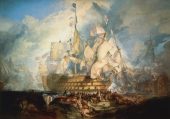
Antelope by Samson Kambalu was unveiled today as the next sculpture on the Fourth Plinth in London’s Trafalgar Square.
The Fourth Plinth is renowned across the globe for bringing world-class contemporary art to London’s most prominent historical public square and Antelope is the 14th commission since the programme of artworks began in 1998.
Supported by Bloomberg Philanthropies, Samson Kambalu’s bronze resin sculpture restages a photograph of Baptist preacher and pan-Africanist John Chilembwe and European missionary John Chorley, taken in 1914 in Nyasayland (now Malawi) at the opening of Chilembwe’s new Baptist church.
Chilembwe is wearing a hat, defying the colonial rule that forbade Africans from wearing hats in front of white people, and is almost twice the size of Chorley. By increasing his scale, the artist is elevating Chilembwe and his story, revealing the hidden narratives of underrepresented peoples in the history of the British Empire in Africa, and beyond.
John Chilembwe was a Baptist pastor and educator who led an uprising in 1915 against British colonial rule in Nyasaland triggered by the mistreatment of refugees from Mozambique and the conscription to fight German troops during WWI. He was killed and his church destroyed by the colonial police. Though his rebellion was ultimately unsuccessful, Malawi, which gained independence in 1964, celebrates John Chilembwe Day on January 15th and the uprising is viewed as the beginning of the Malawi independence struggle.
The artist, Samson Kambalu, was born in 1975 in Malawi, and now lives and works in Oxford where he is Associate Professor of Fine Art and a lifelong fellow at Magdalen College, Oxford University.
His sculpture, which was made in Deptford, was selected by the Fourth Plinth Commission Group, chaired by Ekow Eshun, following an exhibition at the National Gallery where nearly 17,500 people commented on the selection.
For over two decades, The Fourth Plinth has showcased the work of great artists who have not shied away from tackling the important issues of the day. Yinka Shonibare CBE considered the legacy of British colonialism in Nelson’s Ship in a Bottle. Katharina Fritsch commented on gender equality and the masculine posturing in the square with her work Hahn/Cock. Michael Rakowitz’s recreation of the Lamassu, a winged bull and protective deity that was destroyed in Nineveh (near modern day Mosul) in 2015 shone a light on the devastating impact of war on cultural heritage, and Heather Phillipson’s THE END presented a giant swirl of whipped cream, a cherry, a fly and a drone that transmits a live feed of Trafalgar Square, suggesting both exuberance and unease and responding to Trafalgar Square as a site of celebration and protest.
Antelope will be on the Fourth Plinth until September 2024 and is a highlight of the inaugural Sculpture Week London, a new initiative that will celebrate public art throughout London in a collaboration between Frieze, Sculpture in the City and the Mayor of London's Fourth Plinth Programme.
The Fourth Plinth is funded by the Mayor of London, Arts Council England and Bloomberg Philanthropies. It features on Bloomberg Connects, the free app that allows users to access over 100 museums, galleries, and cultural spaces around the world anytime, anywhere. Through the Fourth Plinth guide, users can access a range of exclusive content, including a video of Kambalu discussing the Fourth Plinth installation and his practice more broadly, information on past commissions and a welcome from Justine Simons OBE, London's Deputy Mayor for Culture and Creative Industries.
Samson Kambalu said: “I am thrilled to have been invited to create a work for London’s most iconic public space, and to see John Chilembwe’s story elevated. Antelope on the Fourth Plinth was ever going to be a litmus test for how much I belong to British society as an African and a cosmopolitan. Chilembwe selected himself for the Fourth Plinth, as though he waited for this moment. He died in an uprising but ends up victorious.”
Sadiq Khan, Mayor of London, said: “I’m delighted that Samson Kambalu’s inspiring sculpture has become the latest to take its place on the Fourth Plinth. Our world-renowned sculpture prize entertains, educates and inspires. Samson is shining a light on an often overlooked part of our country’s history and I’m sure it will encourage discussion about the fight for freedom and equality. As we continue to fight against racism and stand-up for equality across our city and country, it is a message that remains just as important today.”
Justine Simons OBE, Deputy Mayor for Culture and the Creative Industries, said: “The Fourth Plinth is a symbol of our capital’s world-leading creativity and a clear sign of the importance of the culture to our city. For more than two decades, it has showcased the work of great artists and sparked conversation and debate about a wide range of subjects. By revealing how a simple hat became a symbol for the fight for equality, Samson Kambalu’s bronze sculpture will send an important message to Londoners and the millions who visit Trafalgar Square every year.”
Ekow Eshun, Chair of the Fourth Plinth Commissioning Group, said: "Antelope is something of a Trojan Horse. At first glance it appears like a traditional bronze statue, similar to the other statues around Trafalgar Square. But it is subtly subversive, highlighting the bravery and legacy of an underrepresented figure in the history of the British Empire in Africa. This sculpture tells a fascinating story, one that deserves to be better known and shared with all of London”.
Jemma Read, Global Head of Corporate Philanthropy at Bloomberg LP, said: "The Fourth plinth is a unique installation which celebrates our global influences and acknowledges our shared history. Samson Kambalu's Antelope is an important addition to this iconic space, shedding light on a pivotal moment and encouraging challenging conversations. We're proud to support the Mayor of London to bring this work to life and to enable communities around the world to experience it through the Bloomberg Connects guide." Photo by Rob Young from United Kingdom, Wikimedia commons.




































